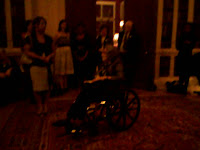Kim Gandy, National Organization for Women, reminds us that 16% is not great, but that we are moving steadily. However, we’re moving not because some critical mass has been reached in society but rather because there are women like those here who have been funding and running campaigns.
Gandy notes that women’s unemployment is rising faster and our median earnings are falling faster (esp single mothers) than men’s, and it’s affecting us longterm, in terms of savings. This demographic, this one that is hurting most, is going to be the one to decide this election. Whichever candidate can reach out to them is going to win.










